Yifan Bai
Kimi K2: Open Agentic Intelligence
Jul 28, 2025Abstract:We introduce Kimi K2, a Mixture-of-Experts (MoE) large language model with 32 billion activated parameters and 1 trillion total parameters. We propose the MuonClip optimizer, which improves upon Muon with a novel QK-clip technique to address training instability while enjoying the advanced token efficiency of Muon. Based on MuonClip, K2 was pre-trained on 15.5 trillion tokens with zero loss spike. During post-training, K2 undergoes a multi-stage post-training process, highlighted by a large-scale agentic data synthesis pipeline and a joint reinforcement learning (RL) stage, where the model improves its capabilities through interactions with real and synthetic environments. Kimi K2 achieves state-of-the-art performance among open-source non-thinking models, with strengths in agentic capabilities. Notably, K2 obtains 66.1 on Tau2-Bench, 76.5 on ACEBench (En), 65.8 on SWE-Bench Verified, and 47.3 on SWE-Bench Multilingual -- surpassing most open and closed-sourced baselines in non-thinking settings. It also exhibits strong capabilities in coding, mathematics, and reasoning tasks, with a score of 53.7 on LiveCodeBench v6, 49.5 on AIME 2025, 75.1 on GPQA-Diamond, and 27.1 on OJBench, all without extended thinking. These results position Kimi K2 as one of the most capable open-source large language models to date, particularly in software engineering and agentic tasks. We release our base and post-trained model checkpoints to facilitate future research and applications of agentic intelligence.
FutureSightDrive: Thinking Visually with Spatio-Temporal CoT for Autonomous Driving
May 23, 2025Abstract:Visual language models (VLMs) have attracted increasing interest in autonomous driving due to their powerful reasoning capabilities. However, existing VLMs typically utilize discrete text Chain-of-Thought (CoT) tailored to the current scenario, which essentially represents highly abstract and symbolic compression of visual information, potentially leading to spatio-temporal relationship ambiguity and fine-grained information loss. Is autonomous driving better modeled on real-world simulation and imagination than on pure symbolic logic? In this paper, we propose a spatio-temporal CoT reasoning method that enables models to think visually. First, VLM serves as a world model to generate unified image frame for predicting future world states: where perception results (e.g., lane divider and 3D detection) represent the future spatial relationships, and ordinary future frame represent the temporal evolution relationships. This spatio-temporal CoT then serves as intermediate reasoning steps, enabling the VLM to function as an inverse dynamics model for trajectory planning based on current observations and future predictions. To implement visual generation in VLMs, we propose a unified pretraining paradigm integrating visual generation and understanding, along with a progressive visual CoT enhancing autoregressive image generation. Extensive experimental results demonstrate the effectiveness of the proposed method, advancing autonomous driving towards visual reasoning.
TACOcc:Target-Adaptive Cross-Modal Fusion with Volume Rendering for 3D Semantic Occupancy
May 19, 2025Abstract:The performance of multi-modal 3D occupancy prediction is limited by ineffective fusion, mainly due to geometry-semantics mismatch from fixed fusion strategies and surface detail loss caused by sparse, noisy annotations. The mismatch stems from the heterogeneous scale and distribution of point cloud and image features, leading to biased matching under fixed neighborhood fusion. To address this, we propose a target-scale adaptive, bidirectional symmetric retrieval mechanism. It expands the neighborhood for large targets to enhance context awareness and shrinks it for small ones to improve efficiency and suppress noise, enabling accurate cross-modal feature alignment. This mechanism explicitly establishes spatial correspondences and improves fusion accuracy. For surface detail loss, sparse labels provide limited supervision, resulting in poor predictions for small objects. We introduce an improved volume rendering pipeline based on 3D Gaussian Splatting, which takes fused features as input to render images, applies photometric consistency supervision, and jointly optimizes 2D-3D consistency. This enhances surface detail reconstruction while suppressing noise propagation. In summary, we propose TACOcc, an adaptive multi-modal fusion framework for 3D semantic occupancy prediction, enhanced by volume rendering supervision. Experiments on the nuScenes and SemanticKITTI benchmarks validate its effectiveness.
Multi-Agent Path Finding Using Conflict-Based Search and Structural-Semantic Topometric Maps
Jan 29, 2025



Abstract:As industries increasingly adopt large robotic fleets, there is a pressing need for computationally efficient, practical, and optimal conflict-free path planning for multiple robots. Conflict-Based Search (CBS) is a popular method for multi-agent path finding (MAPF) due to its completeness and optimality; however, it is often impractical for real-world applications, as it is computationally intensive to solve and relies on assumptions about agents and operating environments that are difficult to realize. This article proposes a solution to overcome computational challenges and practicality issues of CBS by utilizing structural-semantic topometric maps. Instead of running CBS over large grid-based maps, the proposed solution runs CBS over a sparse topometric map containing structural-semantic cells representing intersections, pathways, and dead ends. This approach significantly accelerates the MAPF process and reduces the number of conflict resolutions handled by CBS while operating in continuous time. In the proposed method, robots are assigned time ranges to move between topometric regions, departing from the traditional CBS assumption that a robot can move to any connected cell in a single time step. The approach is validated through real-world multi-robot path-finding experiments and benchmarking simulations. The results demonstrate that the proposed MAPF method can be applied to real-world non-holonomic robots and yields significant improvement in computational efficiency compared to traditional CBS methods while improving conflict detection and resolution in cases of corridor symmetries.
GridShow: Omni Visual Generation
Dec 17, 2024Abstract:In this paper, we introduce GRID, a novel paradigm that reframes a broad range of visual generation tasks as the problem of arranging grids, akin to film strips. At its core, GRID transforms temporal sequences into grid layouts, enabling image generation models to process visual sequences holistically. To achieve both layout consistency and motion coherence, we develop a parallel flow-matching training strategy that combines layout matching and temporal losses, guided by a coarse-to-fine schedule that evolves from basic layouts to precise motion control. Our approach demonstrates remarkable efficiency, achieving up to 35 faster inference speeds while using 1/1000 of the computational resources compared to specialized models. Extensive experiments show that GRID exhibits exceptional versatility across diverse visual generation tasks, from Text-to-Video to 3D Editing, while maintaining its foundational image generation capabilities. This dual strength in both expanded applications and preserved core competencies establishes GRID as an efficient and versatile omni-solution for visual generation.
Projecting Points to Axes: Oriented Object Detection via Point-Axis Representation
Jul 11, 2024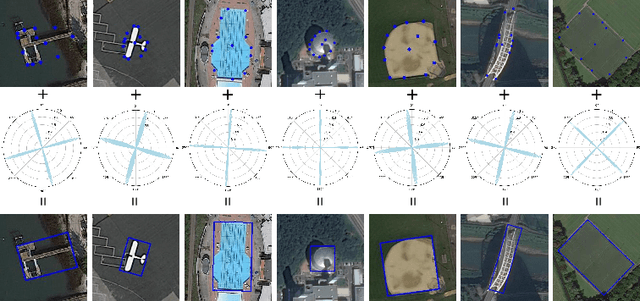

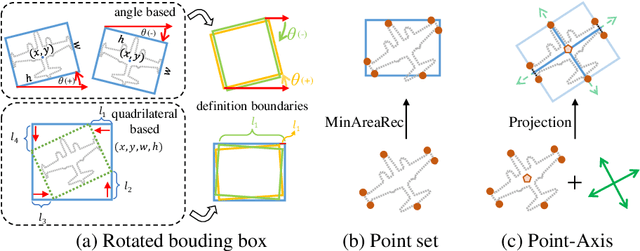
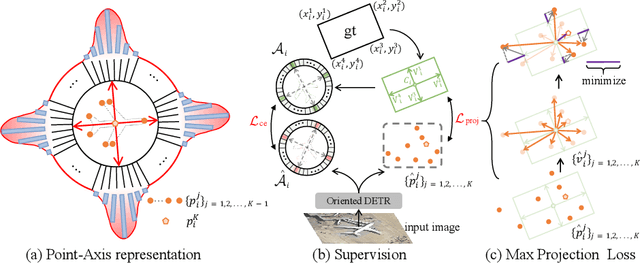
Abstract:This paper introduces the point-axis representation for oriented object detection, emphasizing its flexibility and geometrically intuitive nature with two key components: points and axes. 1) Points delineate the spatial extent and contours of objects, providing detailed shape descriptions. 2) Axes define the primary directionalities of objects, providing essential orientation cues crucial for precise detection. The point-axis representation decouples location and rotation, addressing the loss discontinuity issues commonly encountered in traditional bounding box-based approaches. For effective optimization without introducing additional annotations, we propose the max-projection loss to supervise point set learning and the cross-axis loss for robust axis representation learning. Further, leveraging this representation, we present the Oriented DETR model, seamlessly integrating the DETR framework for precise point-axis prediction and end-to-end detection. Experimental results demonstrate significant performance improvements in oriented object detection tasks.
Is a 3D-Tokenized LLM the Key to Reliable Autonomous Driving?
May 28, 2024Abstract:Rapid advancements in Autonomous Driving (AD) tasks turned a significant shift toward end-to-end fashion, particularly in the utilization of vision-language models (VLMs) that integrate robust logical reasoning and cognitive abilities to enable comprehensive end-to-end planning. However, these VLM-based approaches tend to integrate 2D vision tokenizers and a large language model (LLM) for ego-car planning, which lack 3D geometric priors as a cornerstone of reliable planning. Naturally, this observation raises a critical concern: Can a 2D-tokenized LLM accurately perceive the 3D environment? Our evaluation of current VLM-based methods across 3D object detection, vectorized map construction, and environmental caption suggests that the answer is, unfortunately, NO. In other words, 2D-tokenized LLM fails to provide reliable autonomous driving. In response, we introduce DETR-style 3D perceptrons as 3D tokenizers, which connect LLM with a one-layer linear projector. This simple yet elegant strategy, termed Atlas, harnesses the inherent priors of the 3D physical world, enabling it to simultaneously process high-resolution multi-view images and employ spatiotemporal modeling. Despite its simplicity, Atlas demonstrates superior performance in both 3D detection and ego planning tasks on nuScenes dataset, proving that 3D-tokenized LLM is the key to reliable autonomous driving. The code and datasets will be released.
ARTrackV2: Prompting Autoregressive Tracker Where to Look and How to Describe
Dec 29, 2023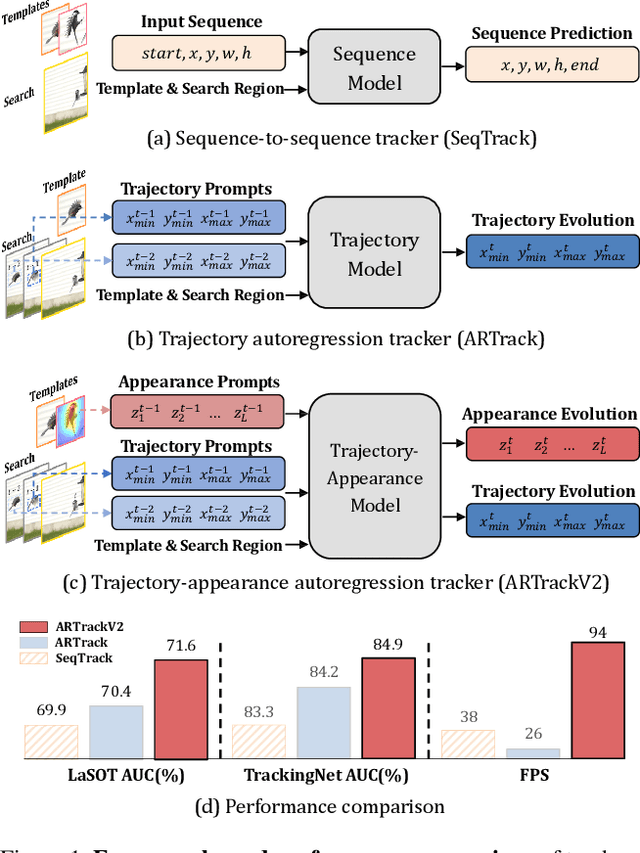
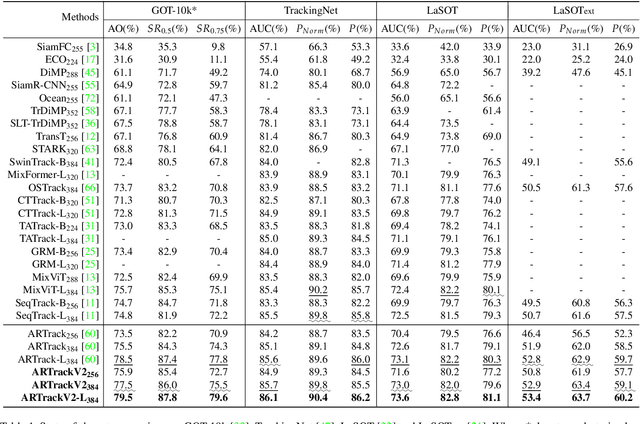
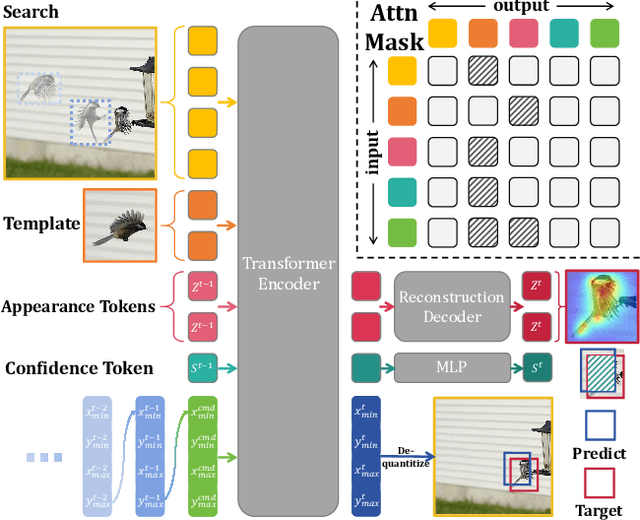
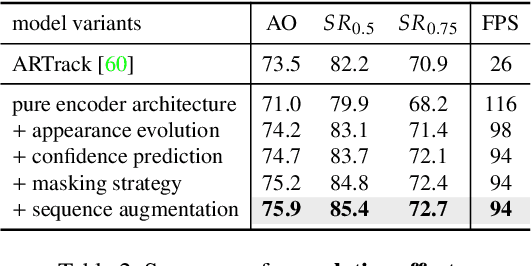
Abstract:We present ARTrackV2, which integrates two pivotal aspects of tracking: determining where to look (localization) and how to describe (appearance analysis) the target object across video frames. Building on the foundation of its predecessor, ARTrackV2 extends the concept by introducing a unified generative framework to "read out" object's trajectory and "retell" its appearance in an autoregressive manner. This approach fosters a time-continuous methodology that models the joint evolution of motion and visual features, guided by previous estimates. Furthermore, ARTrackV2 stands out for its efficiency and simplicity, obviating the less efficient intra-frame autoregression and hand-tuned parameters for appearance updates. Despite its simplicity, ARTrackV2 achieves state-of-the-art performance on prevailing benchmark datasets while demonstrating remarkable efficiency improvement. In particular, ARTrackV2 achieves AO score of 79.5\% on GOT-10k, and AUC of 86.1\% on TrackingNet while being $3.6 \times$ faster than ARTrack. The code will be released.
SA-reCBS: Multi-robot task assignment with integrated reactive path generation
Apr 13, 2023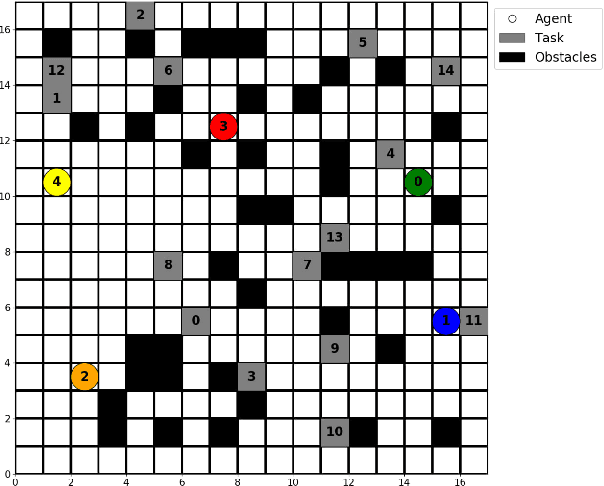

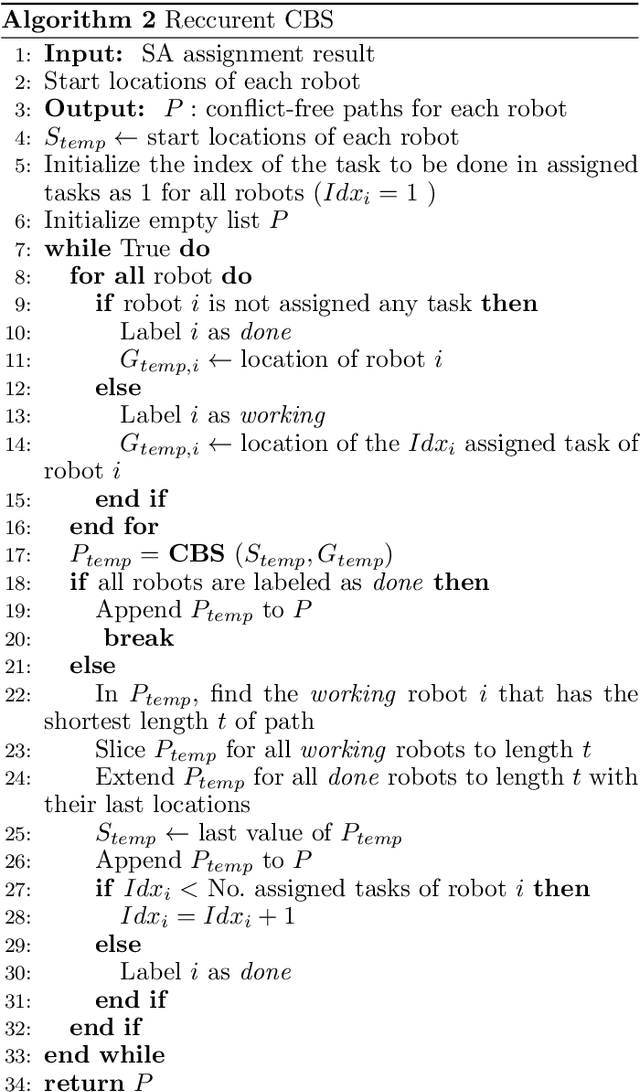
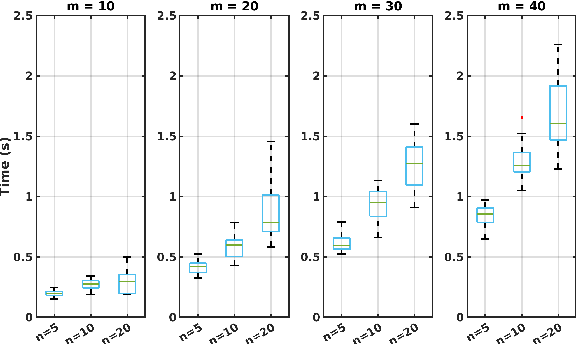
Abstract:In this paper, we study the multi-robot task assignment and path-finding problem (MRTAPF), where a number of agents are required to visit all given goal locations while avoiding collisions with each other. We propose a novel two-layer algorithm SA-reCBS that cascades the simulated annealing algorithm and conflict-based search to solve this problem. Compared to other approaches in the field of MRTAPF, the advantage of SA-reCBS is that without requiring a pre-bundle of goals to groups with the same number of groups as the number of robots, it enables a part of agents needed to visit all goals in collision-free paths. We test the algorithm in various simulation instances and compare it with state-of-the-art algorithms. The result shows that SA-reCBS has a better performance with a higher success rate, less computational time, and better objective values.
Immersive Text Game and Personality Classification
Mar 20, 2022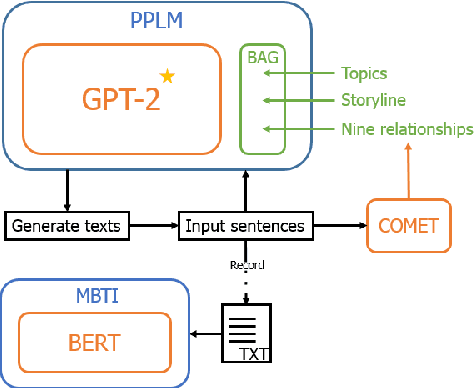
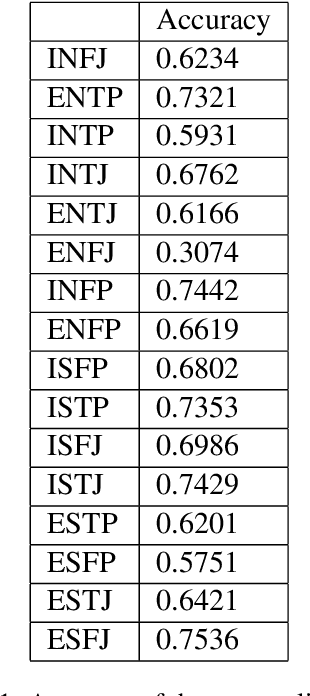

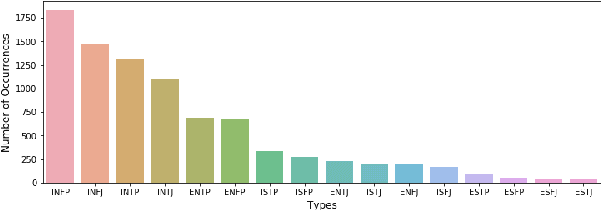
Abstract:We designed and built a game called \textit{Immersive Text Game}, which allows the player to choose a story and a character, and interact with other characters in the story in an immersive manner of dialogues. The game is based on several latest models, including text generation language model, information extraction model, commonsense reasoning model, and psychology evaluation model. In the past, similar text games usually let players choose from limited actions instead of answering on their own, and not every time what characters said are determined by the player. Through the combination of these models and elaborate game mechanics and modes, the player will find some novel experiences as driven through the storyline.
 Add to Chrome
Add to Chrome Add to Firefox
Add to Firefox Add to Edge
Add to Edge